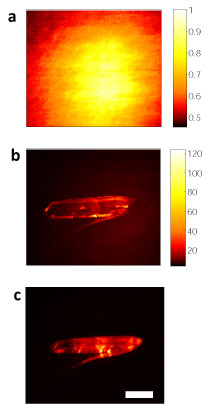
Technique ‘Pre-Corrects’ Microscope Illumination
REHOVOT, Israel, Sept. 11, 2014 — A new adaptive optics technique focuses laser light through dense tissues without the need for an invasive guide star.
The technique can resolve a point less than a micron across. It was developed by a team led by the Weizmann Institute of Science.
“Until today, all-optical focusing through scattering media required invasively implanting a point-like guide star,” said Ori Katz, a postdoctoral researcher at the Langevin Institute in Paris who worked on the study. “For the first time, we have shown that it is possible to focus light through visually opaque barriers without using such a guide star.”

Three views of the same target: (a) was made using conventional two-photon fluorescence; (b) was made using the new waveform shaping, guide star-free technique; (c) is a direct image of the target sample used to verify the accuracy of the new technique. Courtesy of Optica.
In the study, the researchers modified a standard two-photon scanning microscope by incorporating a high-resolution wavefront shaping device. This allowed them to focus on a single point behind an obscuring scattering layer.
Light pulses were directed through that obscuring layer and onto a target. As the light passed through an intervening layer, it became highly scattered. The researchers altered the original pulsed light to form a focused beam that they later scanned to generate an image of the fluorescent object hidden behind the obscuring layer.
“Imagine shining a flashlight through a thick fogbank to try to see a single dot,” said Weizmann professor Dr. Yaron Silberberg. “The light would become so scattered as it traveled through the fog that you wouldn’t be able to make out what was hidden inside. By carefully shaping the light going in, however, it would be possible to home in on your target.”
As the two-photon microscope responded in a nonlinear manner to the intensity of the excitation light, the researchers were able to obtain information about the wavefront, which is required to compensate for the scattering. With conventional adaptive optics techniques, there is no way to correct such a highly scattered focus.
“What we have discovered is that it’s possible to efficiently ‘pre-correct’ the laser beam using the nonlinear fluorescence signal,” Katz said. “The end result is that instead of having a distorted, blurred light source on the object to be imaged, we have a tightly focused, or in this case refocused, beam of light.”
Additional studies are needed to ascertain the use of this new technique for future applications such as microscopic imaging or guiding laser surgery.
The research was published in Optica. (doi: 10.1364/optica.1.000170).
For more information, visit www.weizmann.ac.il.
Published: September 2014